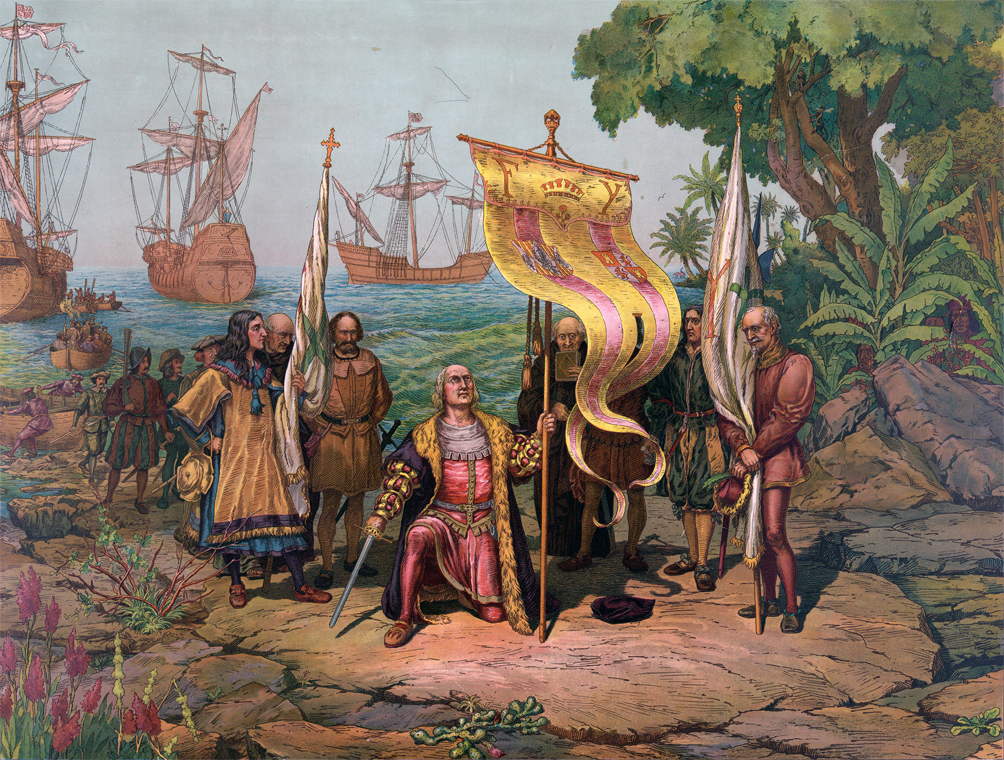

In this unit you will study Demonstrative Pronouns.




Imagen:Columbus and his crew arriving in the New world. Retrieved October, 2016 from https://en.wikipedia.org/wiki/Spanish_diaspora#/media/File:Columbus_Taking_Possession.jpg
Instructions: Read about the Spanish diaspora in the US.
The Spanish diaspora consists of Spanish people and their descendants who emigrated from Spain. This diaspora is concentrated in places that were part of the Spanish Empire. One of the countries to which they have migrated is The United States.
After the age of Discovery, the Spanish were the earliest and one of the largest communities to emigrate out of Europe. That dispersion had a particular concentration in North America.
Spanish diaspora. Retrieved and adapted October, 2016 from https://en.wikipedia.org/wiki/Spanish_diaspora

Instructions: Read about the Spanish diaspora in the US.
The Spanish are the longest-established European-American group with a continuous presence in Florida since 1565. That presence is found in large concentrations in five major states from 1940 through the early twenty-first century. In 1940, this was the highest concentration of Spaniards in New York, followed by California, Florida, New Jersey and Pennsylvania.
That immigration to the United Stated from Spain was minimal but steady during the first half of the nineteenth century, with an increase during the 1850s and 1860s resulting from the social disruption of the Carlist civil wars. Much larger numbers of those Spanish immigrants entered the country in the first quarter of the twentieth century due to the same circumstances of rural poverty and urban congestion that led other Europeans to emigrate in that period, as well as unpopular wars.
Spanish diaspora. Retrieved and adapted October, 2016 from https://en.wikipedia.org/wiki/Spanish_diaspora
Instructions: Choose True or False for the following statements

Instructions: Read about Demonstrative pronouns.
We use Demonstrative pronouns to point out specific people, animals or things.
There are only four Demonstrative pronouns:
Examples
Who is that girl? She is my cousin.
What are these? They are my markers.
Instructions: Fill in the blanks with this, that, these or those.

Instructions: Drag and drop a demonstrative pronoun to complete the following text.
Spanish-Americans in the United States are found in large concentrations in five major states from 1940 through the early twenty-first century. highest concentration of Spaniards were in New York, followed by of California, Florida, New Jersey and Pennsylvania. In 1990 Florida ranked first, followed by California, New York, Texas, and New Jersey. California now ranked highest, followed by, Florida, New York, New Jersey, and Texas.
figures show that there was never the mass emigration from Iberia that there was from Latin America. is evident in the figures that Spanish immigration peaked in the 1910s and 1920s.

Instructions: Write the most suitable demonstrative pronoun.
is the story about Spanish immigration to Hawaii. It began in 1907 when the Hawaiian government and the Hawaiian Sugar Planters' Association (HSPA) decided to supplement their importation of Portuguese workers to Hawaii with workers recruited from Spain. Importation of Spanish laborers, along with their families, continued until 1913. The high cost associated with shipping Portuguese laborers and their families to Hawaii, and the reality that many of them remained on the plantations only long enough to fulfill their contractual obligations, led the Hawaiian Sugar Planters' Association to encourage the government to consider alternate sources of labor. Spain in particular was a viable source of contract workers.
Nevertheless, emigrations were to the mainland United States, generally California, as soon as they could in search of greater opportunity. Although the Spanish tended to move on, they were quickly supplanted by Spanish-speaking immigrants from the Philippines and Puerto Rico.